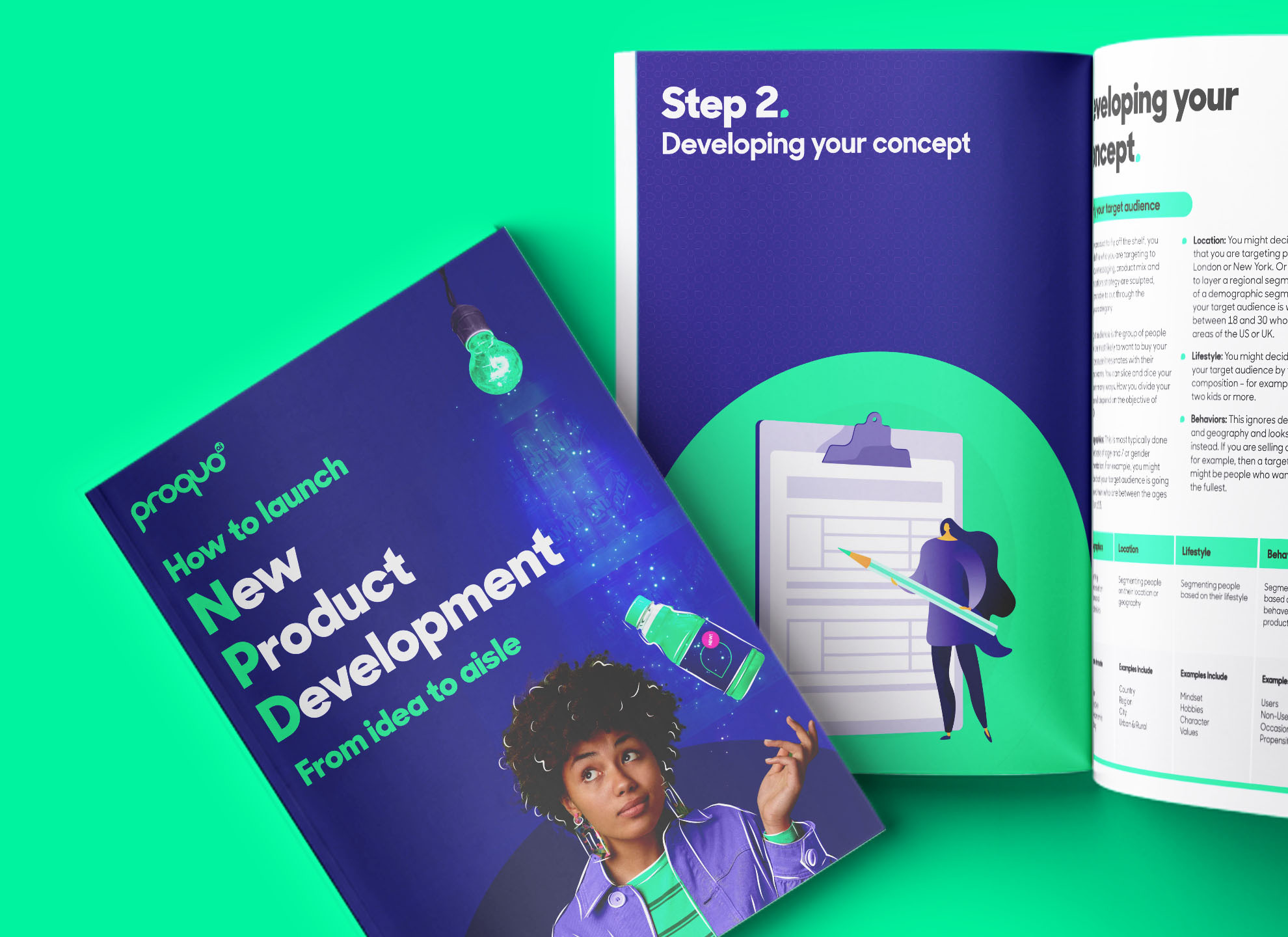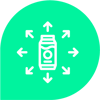How to launch New Product Development: from idea to aisle
Guide

Are you looking to drive revenue, grow loyalty, or respond to changing customer needs? A new product release can help with that.
To access an airtight step-by-step New Product Development (NPD) process, keep reading.

What is the commercial objective behind your NPD? Try to distill this into a few sentences for maximum clarity.
Each business will have a unique set of intentions driving them towards this venture.
Common objectives are:
Before settling on the pathway for your NPD, also consider how it fits into your company’s overarching business strategy. For your product to be successful, it needs to align with your business’ strategic goals. This could be things such as:
Once you have determined your strategic fit and defined your commercial objectives, you are now ready to craft a concept that will deliver against these measurables.


For a new product to fly off the shelf, you need to define who you are targeting to ensure your messaging, product mix and communications strategy are sculpted, focused and able to cut through the noise of your category.
You can slice and dice your audience in many ways. How you divide your audience will depend on the objective of your NPD:

Launching an NPD is a worthwhile venture, that can have a huge impact on the commercial value of a business. But it’s also time-consuming and costly, so brands need to outline clearly why they want to create a new product before they embark on this process.
It’s important to gather and analyze data on your brand, competition and category before you go all in. Take notice of gaps in your category that you could fill or try to detect any emerging trends you can capitalize on.
If you see raspberries are popping off the shelves, releasing a raspberry flavored product would help to increase your relevancy in the market, for example. If consumer habits are changing as a result of COVID, how are people in your category looking for different formats, flavors or usage occasions?
Take a look at the other brands currently playing in your space to understand where the opportunity is for your brand to focus on. Consider which needs in your category are currently being met and unmet, and how can you use this information to form a competitive advantage.

Let’s take Fever-Tree as an example here. Before launching their beloved mixers, Fever-Tree capitalized on a gap in the market for an aspirational, premium and high quality mixer. When positioning their product in market, they focused their attention on this area, releasing a premium, aesthetically pleasing range of mixers to disrupt a stagnant category. The rest is history.
There's no hard and fast rule on when is a good time to create a new product. It could depend on your business objectives for the year, your competitors' share or be influenced by movements in the category. If you have the time and resources to establish the product, go for it. An audience loves to see something new, so keep the momentum going to excite and delight your customers.
Every new product idea should be based on a fundamental human truth that gives meaning to a consumer's life, providing a new perspective on an old issue.
What a fundamental human truth is:
Human truth is at the core of every great idea. It is an undeniable truth that is shared between members of a group. To judge whether you have a human truth, just wait for a reaction along the lines of 'No way, you do that too? I thought I was the only one'. The fundamental aim of a human truth is to unite a group of people in a shared belief.
To find this human truth, speak to consumers in your category to discover what they have in common. Use open-ended questions and multi-sensorial activities to get your group talking. To really dig down into the human truth, continuously ask your consumers 'why' they have come to this conclusion, for more in-depth responses.
Another great way of identifying a human truth is through active observation. Place yourself into the midst of your target audience and observe their behavior in a natural setting. If your target audience was young men in college, for example, go to places where they congregate, like a fraternity. When people aren’t aware they’re being watched, you’re more likely to gain an accurate, unbiased human truth.
Let’s go back to Fever-Tree. They found their human truth after they decided to focus on the mechanics of how a drink is constructed. They understood making a drink was a very personal decision, and there was huge amount of debate on the quantity of mixer users chose to put into their drinks, compared to spirit. They leveraged this human truth to create a springboard for their campaign idea, “If ¾ of your drink is a mixer, why not mix it with the best?” Previously, tonic had been considered an afterthought, and not as important as the gin in the drink. That was until Fever-Tree came along, launching an irresistibly tasty and aspirational mixer that would forever change the course of the conversation, skewing it away from gin and towards tonic.

For a product to have good market value, there needs to be some benefit to it. Consumers should believe that by using the product, their life will in some way be enhanced.
Product benefits are built off core consumer needs. There are two types of product benefits:
For Fever-Tree, a functional benefit is the improved taste of their mixer, compared to more traditional brands. An emotional benefit is how the product makes its audience feel. When drinking a Fever-Tree it's an experience and customers are made to feel special, decadent and aspirational. This is something that's reflected through the packaging of the brand which is both premium and exclusive.

A reason to believe is a statement or proof-point that gives an audience cause to believe in your idea.
To establish your RTB, consider your product benefits. Is your product supported by science? Or are you creating something entirely new that will shake up your category?
If there are any claims you can make about your product to distinguish it from competitors, these are useful to include and there are a huge variety to choose from.
Claims are crucial for new products as they provide context for customers. They are a starting point in your communication story and should aim to educate and reassure customers about the quality of your product.
When using claims, be careful not to exaggerate and to remain authentic. A claim should remind customers of the credibility and value of your service, to drive the selling point of your product.
At this stage in the process, you may have a fully-fledged idea, a mock-up of your NPD, or somewhere between the two. However far you’ve gotten, it’s important to take a step back and understand if what you are trying to build has the capacity to deliver your intended results.
Revert back to the opportunity you outlined at the beginning of the NPD process, your core objective for launching the project. Was your opportunity to drive penetration, increase your customer base or steal market share? Whichever goal you had in mind, focus on it to determine whether your idea is feasible and if it will lead to your desired objective.
To understand whether your concept is based on a solid foundation of truth, connect with your customers. Conducting 1-2-1 interviews and further conversations with your target audience are good ways to do this, but for a more exact approach, you’ll need CreativeLab.

CreativeLab is ProQuo’s instant creative optimization system, giving you guidance, in hours, on how to improve your ideas before they launch. Simply add your assets into the platform – at any stage of development - and in a few hours you'll receive feedback from over 300 people, with actionable guidance on what to do to improve it.
This access will be crucial to the development of your NPD, as it will help you to see if your concept is landing amongst your target audience, and which areas you need to tweak before going into full-blown production. If you are struggling to choose between a few different concepts, it can also help you to see which idea will have the strongest impact on your target audience.


It's time to put together your tactical plan to take your new product to market.
To guarantee the success of your product, you’ll need a go-to-market (GTM) strategy. A solid GTM strategy takes into consideration multiple Marketing Levers and defines how you will launch your NPD. These Levers range from Communication right through to Merchandising and Customer Experience.
Here are some thought starters to enable you to craft a GTM strategy that ensures your product flies off the shelf:


Communication is of fundamental importance when launching a new product. The way your brand expresses itself and what it tells people moves you closer to your strategic objectives. Look at the benefits of your product and see how you have positioned them. Are you using the correct channels to reach people, and have you accurately conveyed your brand's personality?
First focus on how you are expressing yourself. Are your brand proposition, key messaging and product benefits clearly communicated across your channels and packaging? Evolve your tone of voice and consistently convey this across every brand touchpoint. Flesh out a communication strategy and invest in channels relevant to your target audience. PR, social media, in-store communications, blogs and events are examples of channels which could broaden your reach. Creating a hype is crucial to every new product launch, so make sure you consider how best to release your product in an exciting and innovative way.

Packaging is the outward projection of a brand's identity, and is often the first thing a customer will see in-store or online. When used correctly, it can help to shape people's inclination to interact with a brand.
Good packaging reflects the personality of a brand and should convey the most salient brand qualities in a clear and memorable way through product claims and benefits. The format of the pack is also crucial to consider, so thought should go into colours, sizes, recyclability and the quality of pack. Make sure the size of the pack meets people’s needs and gives them a sense of value for money.

Pricing Do people feel that your brand is worth paying for? Consider whether people may be willing to pay more for your brand, or whether you need to consider lowering your price or investing in promotional discounting?
If you’re looking to increase reach, free trials and promotions will help your brand to connect with people who wouldn’t otherwise trial your product. Product bundles can also be a great way of driving trials of new products. Finally, price tiering throughout your product architecture will make your brand more accessible to a wider range of users.

Distribution is all about ensuring people can easily get hold of your brand and services. Consider how best to maximize your relationship with existing retailers and other partners to extend your reach in a way that reinforces your brand’s values and personality.
If you want more control over your customer journey, consider selling direct to consumer. This will allow you to customize and personalize your selling journey. Consider partnering with ecommerce platforms like Amazon, as these partnerships can often deliver higher sales volumes and build brand awareness. When selling in-store, an important consideration is to build your brand’s share of shelf as this will help to boost awareness and drive rate of sale. Download our guide to crafting a killer trade story to help you perfect your retailer pitch.

Product Delivery refers to your brand’s delivery process. Is your product always in stock and is your delivery process fast and engaging? Think about how your inventory is being managed to make sure distributors always have a steady supply of your product.
To establish yourself as a reliable and consistent brand, consider boosting the speed of your delivery. To lower the barrier of entry to your product, you could also think about decreasing your delivery charges, as these costs can deter customers from proceeding with a purchase. Delivery tracking is also crucial to ensure customers can monitor where their parcels are at each stage of the journey.

Merchandising is the strength of your shelf game. Does your brand's share of shelf match its share of the market? Do people notice your physical presence in store? How on point is your point of sale?
To drive awareness to your new product, consider how to improve your brand’s shelf positioning. Flex your negotiating skills to prove to retailers why you deserve a bigger space. To garner awareness in-store, get creative with your POS or displays, to attract more customers to your area of the store. Sleek, eye-catching displays are what you're after. Aligning with seasonal events and getting creative with display units can help create a buzz around your new product and drive trial.

Promotion helps to broaden and bolster your appeal with your target audience. Promotional strategies offer an easy route for people to try a brand for the first time, in a risk-free way.
Discounts, coupons and sampling are all great promotional methods to boost awareness of your product both in-store and online. If you’re not interested in discounting for trial, consider offering other incentives, like a free return policy or free shipping to customers. A great way to retain customers and boost relationships is through a loyalty scheme - encouraging buyers to repeat purchases through incentives like unlockable discounts or rewards.

So far, you have:
Now, the only thing left to do is to launch your new product.
How you choose to launch your product will depend on the size of your budget, and the channels best suited to your objectives. For large-scale projects, creating a big-bang launch moment through television and outdoor advertising can help you build awareness and reach quickly. Coupling that with immersive experiences and events can help to draw in a crowd and get people to try your product at the same time. For smaller projects, digital campaigns are equally impactful when executed well for a closely targeted audience.
Whether you choose to go big or small when launching your product, read our guide on How to Develop and Optimize Creative to Grow Your Brand which outlines the steps to take in building a campaign to launch your product.

Our platform will take your brand further, faster.
Don’t believe us?
Quick links
Get in touch
hello@proquoai.com
368 9th Ave, New York, NY
10001, USA
1100 Ludlow St, Philadelphia, PA
19107, USA
245 Hammersmith Road, London, United Kingdom, W6 8PW
173 Oxford Road Johannesburg 2196,
South Africa
© 2020 ProQuo AI All rights reservedWebsite by Blend